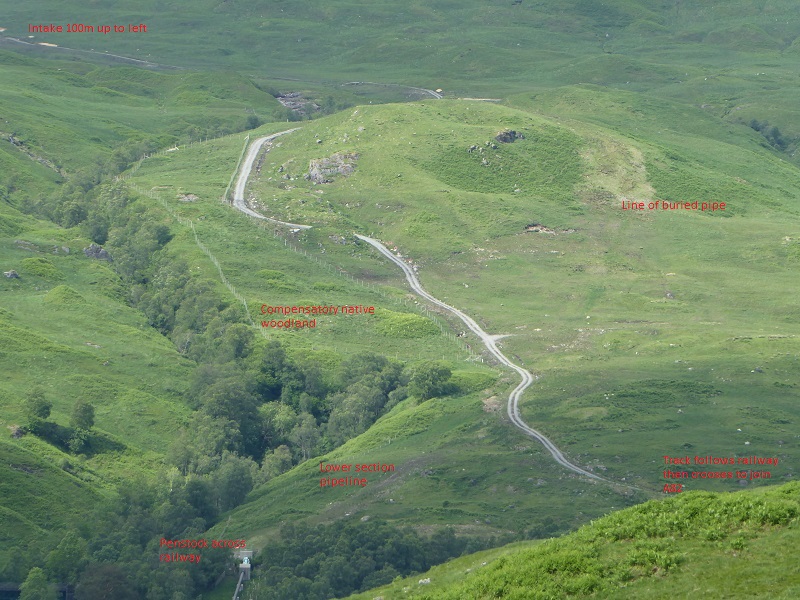
After my recent posts on the lack of agricultural (see here) and (see here) hydro tracks in the Pyrenees National Park and surrounding protected areas and how we could learn from this in Scotland, I thought it worth reminding readers what best practice in the Loch Lomond and Trossachs National Park currently looks like. The last scheme I visited was Eas Eonan, in Glen Falloch, in early July. It forms part of the Derrydarroch Hydro Scheme.
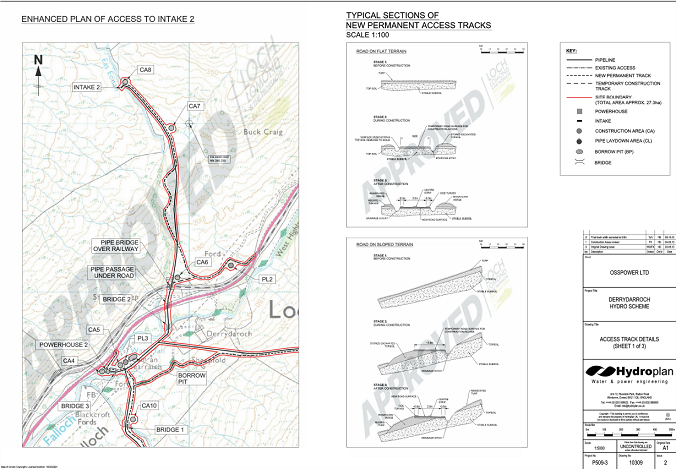
While, on account of their size, the Glen Falloch hydro schemes were agreed by the Scottish Government in 2010, this was with advice from the Loch Lomond and Trossachs National Park Authority Board and the original decision was that tracks would only be allowed for construction purposes and then removed.
Restoration issues relating to the original Scottish Government planning consent
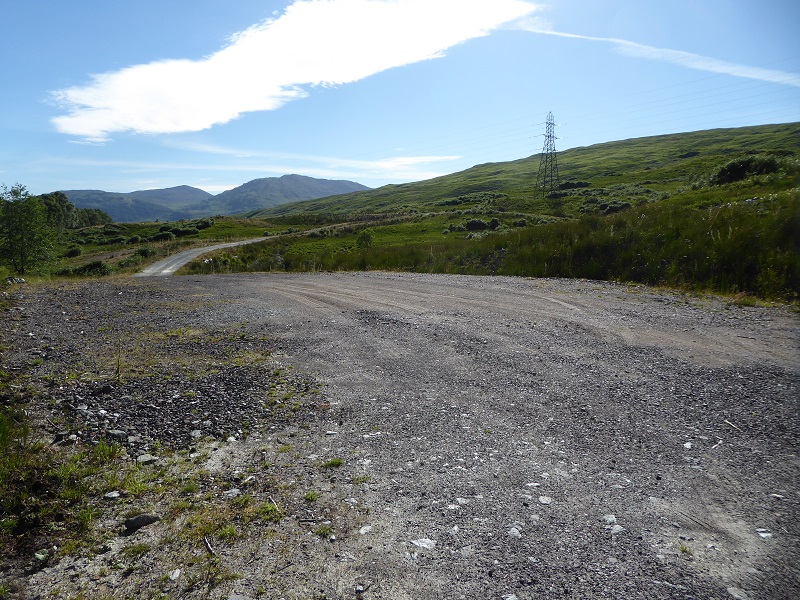
In general, despite the dry weather, the recovery of the ground above the pipeline had been significant since my last visit almost two years ago. While I believe the LLTNPA should be undertaking or commissioning independent ecological reports on pipeline restoration, to look at the extent to which they result in changes in species composition and how this develops over time (the lines of many pipelines are marked by rushes) for most hydro schemes in the National Park pipeline restoration is not the issue.
At the Eas Eonan the main landscape issues relating to the original consent relate to laydown areas used for construction (see photo above) and the intake.
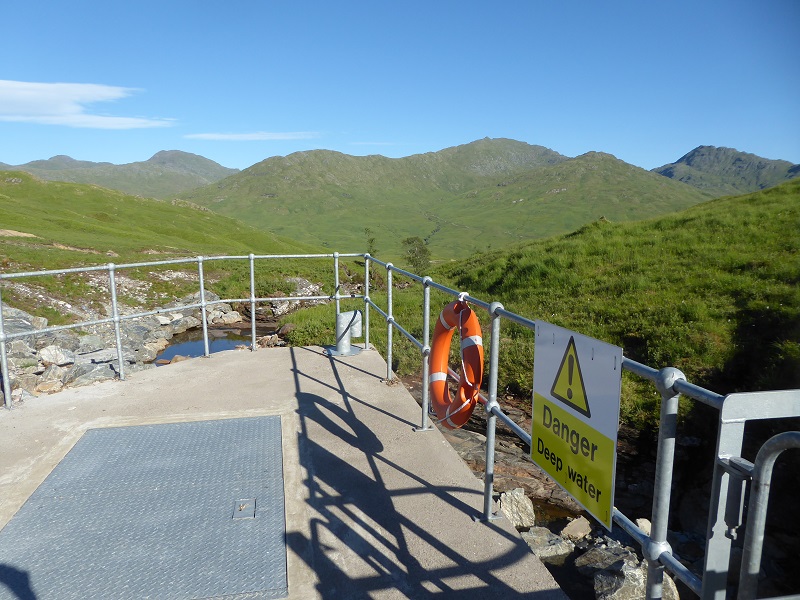
Eas Eonan (intake 2) is a small fast flowing burn on the north side of Glen Falloch cutting a narrow steep sided rocky gorge through the base of a broad open valley with attractive small waterfalls and rocky gorges. (Extract from Planning Report).
The intake has completely changed the character of a section of the burn, a price worth paying perhaps for more sustainable electricity? However, under the terms of the original decision, the view from the intake once the scheme had been restored would still have been wild. All the transport infrastructure along the bottom of Glen Falloch is hidden from this viewpoint and, looking out from the intake, the landscape unspoilt. Now, however, you can see two tracks.
Due to poor design and finishing the visual impact of the intake itself is far more than it needed to be. Many of these issues could still be fixed. A pot of paint, so that pipes and other ironwork were in natural colours, as required by the LLTNPA’s renewables policy would be a start.
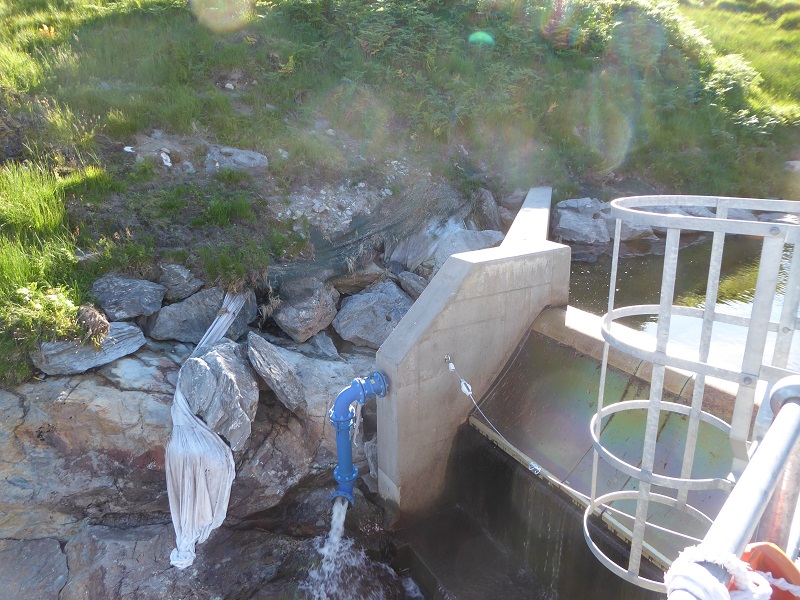
George Paton, a reader who formerly worked on hydro and other construction projects in the Highlands, informed me a couple of months ago that wooden railings, which are promoted as best practice in the LLTNPA renewables guidance, don’t meet health and safety requirements. That probably explains why wooden railings are only seen on the smallest intakes. However, instead of ignoring the challenges created by Health and Safety, why isn’t the LLTNPA working with engineers to find other solutions and then revising its policy? Would not a stone wall and stone facing of the outer dam walls, with material taken from some of the stone spoil littering the edge of the scheme not help Eas Eonan intake blend better into the landscape?
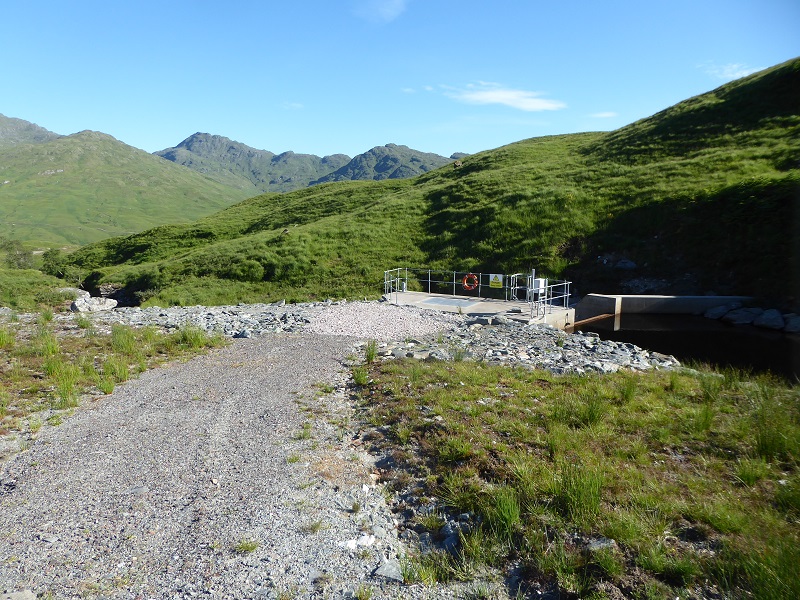
And why isn’t the LLTNPA conducting a public debate with civil engineers on how they could avoid the adverse impacts of rip rap bouldering which turn what could be quite attractive pools into ugly scars?
The access track
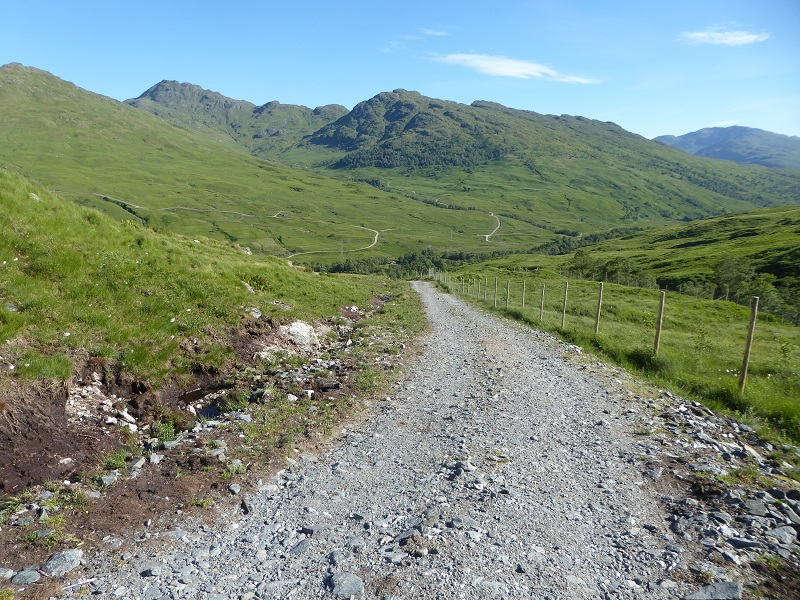
“It is likely that a permanent track will erode the perception of wildness of this open hill slope; in particular the upper section in core wildness area and the point at which the track approaches the intake and the upper glen where there is intervisibility with Ben Dubcraig. Here the perception of wildness is more apparent and any extensive or adverse development will add to the cumulative impacts of the Glen Falloch schemes.” (Extract from Planning Officer’s report).
The access track is a much bigger issue. The Glen Falloch estate made a planning applications to retain the tracks in 2013 and this was agreed by officers, without reference as far as I have been able to find out to the LLTNPA Board. The delegated report that covers the Eas Eonan Scheme is worth reading (see here), in fact in should it should be obligatory reading for all Board Members.
To the planning officer’s credit, they appear to have been concerned about the impact of retaining the construction tracks and the impact this would have on landscape and wild land (the final section of the track, like the intake is in the Ben Lui Wild Land Area) and asked for more information from Glen Falloch Estates:
On 17 September the agent submitted the following, as a result of a further information request from the case officer:
- Revised LVIA [Landscape Visual Impact Assessment] Report
- Revised Construction Method Statement
- Revised Scheme Layout
- Revised LC Photoset
- Revised Hill Photoset
- Access Track Details
- Scheme Layouts and Wild Land
Unfortunately, apart from the Access Track Details (see map above), these documents are not on the LLTNPA planning portal (I have therefore asked for them) but the conclusion of the Planning Officer is very interesting:
Track for intake 2
For the track to intake 2 the LVIA states that the Intake and upper section of track and pipe route is within wild land areas. It goes on to say that the development of a new track and piperoute will impact on the perception of naturalness of landcover, man-made artefacts, rugged nature and remoteness. It concludes that wild land character will be reduced but wild land character will remain. However the LLTNP wildness policy in the Partnership Plan seeks to protect areas of core wild land from extensive or intrusive man-made development. This track and its construction will impact on a core wildness area as it will introduce a man-made element to this area. The track to intake 2, will cut straight into the slope, require benching in and several bends over a constrained area of slope and then onto a more open shoulder to the intake.
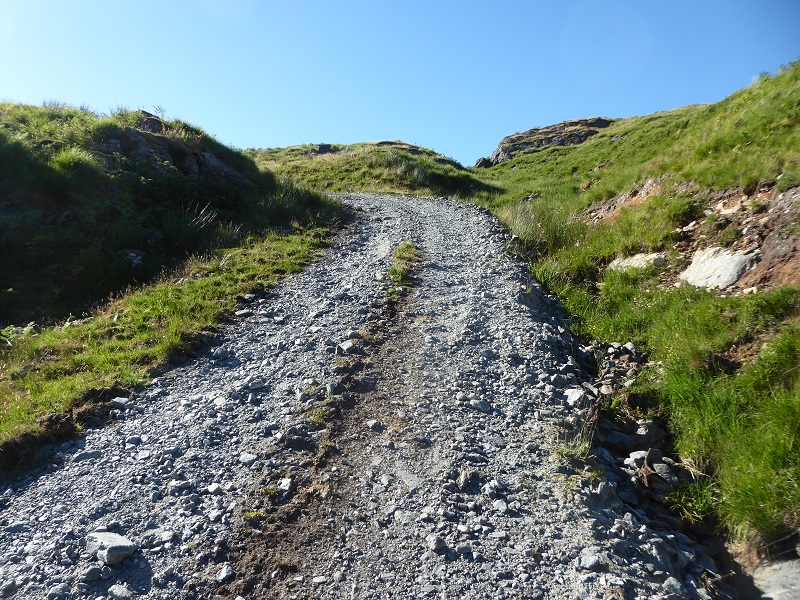
I believe this part of the Planning Officer’s assessment was spot on, with the evidence now on the ground supporting that view. Every reason one might have thought to reject retention of the track. Instead the paragraph continues:
The track will be very visible if constructed unsympathetically and over-engineered. Without attention to the detail and mitigation utilising existing topography the track will be intrusive and certainly add man-made development to the hillside reducing core wildness.
The assumption seems to be that any adverse impact arising from the retention of tracks can be mitigated to make them acceptable. Perhaps this was imposed by senior management but, whatever the explanation for the illogical conclusion, the LLTNPA Board should now have all the evidence they need to show that the assumption that the impacts of any track can be mitigated is wrong,

You cannot cover up major lines running straight along the hillside without landscape scale reforestation and its a moot point whether trees would grow in some of the wetter parts of the glen. The new planted area will do little to conceal the track. This scar is here for the long-term unless the LLTNPA is forced to think again.
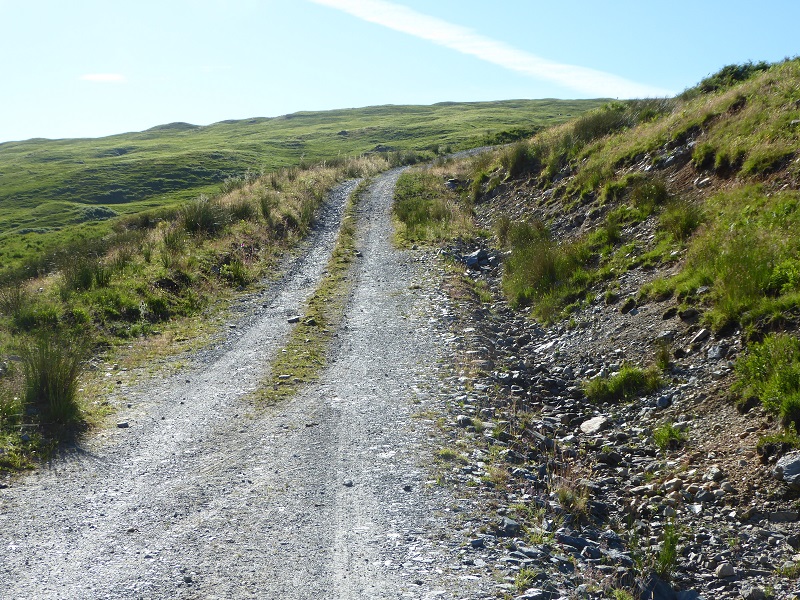
The impact of the track has been increased by a problem the Planning Officer identified, the way the track has been cut into the hillside,
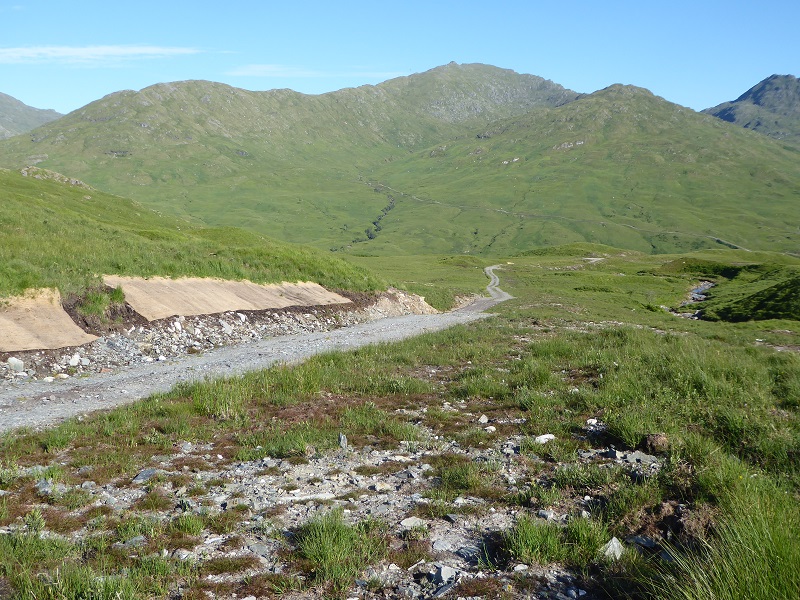
The original planning consent required that the track would be removed and the landscape returned to its original form. That has now been abandoned and the impact of the track has been accentuated by the creation of steep banks and retention of flat areas next to the track (its far cheaper to simply try and cover up part of the aggregate used to construct the track than to remove or re-landscape it).
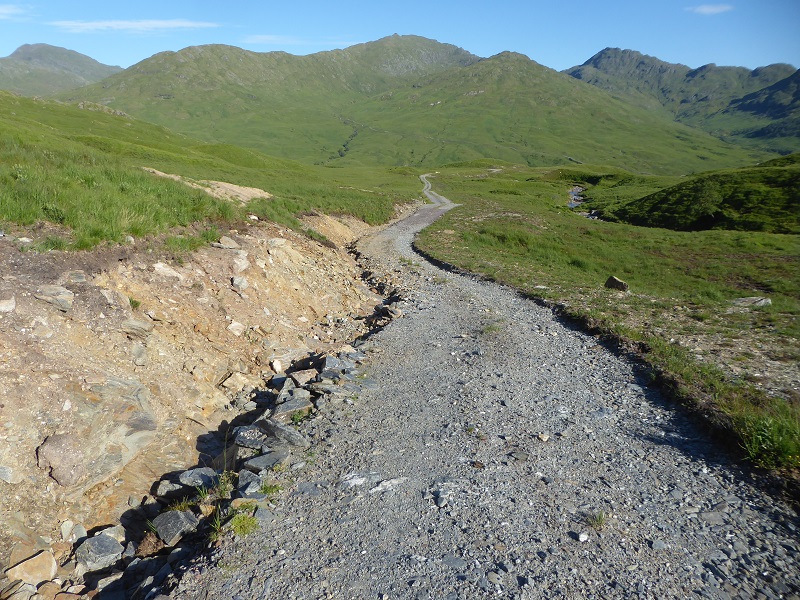
Aside from these fundamental issues regarding the track, there is plenty of other evidence of poor restoration, which could, like those at the intake, be fixed:
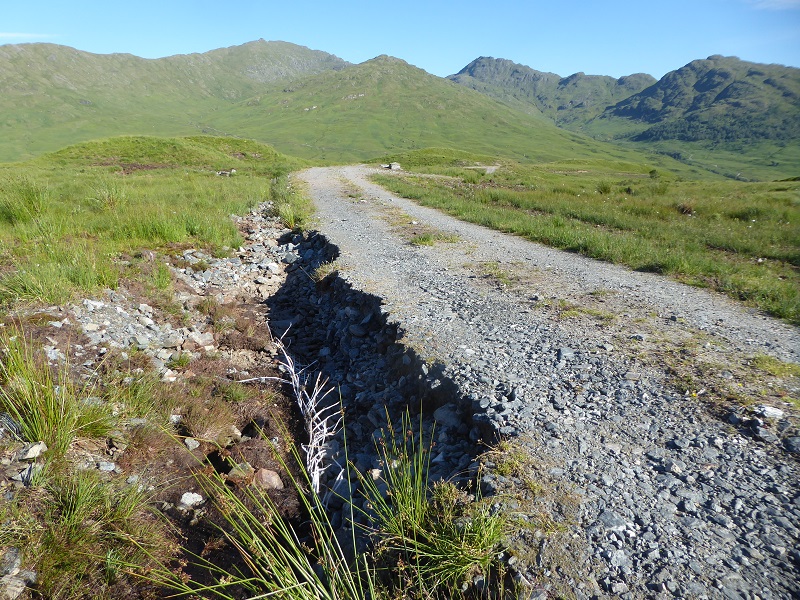
“Impact of the access track on the water environment
The CMS states that cut off drains will be re-established on the topside of the tracks; this will not serve to transfer water horizontally for long distances or to concentrate run off where it did not exist before. Culverts under the tracks will be placed to preserve the continuity of the existing” (Extract from Planning Report)
What is this if not a long drainage ditch?
And everywhere you look parking bays/areas of unrestored track:
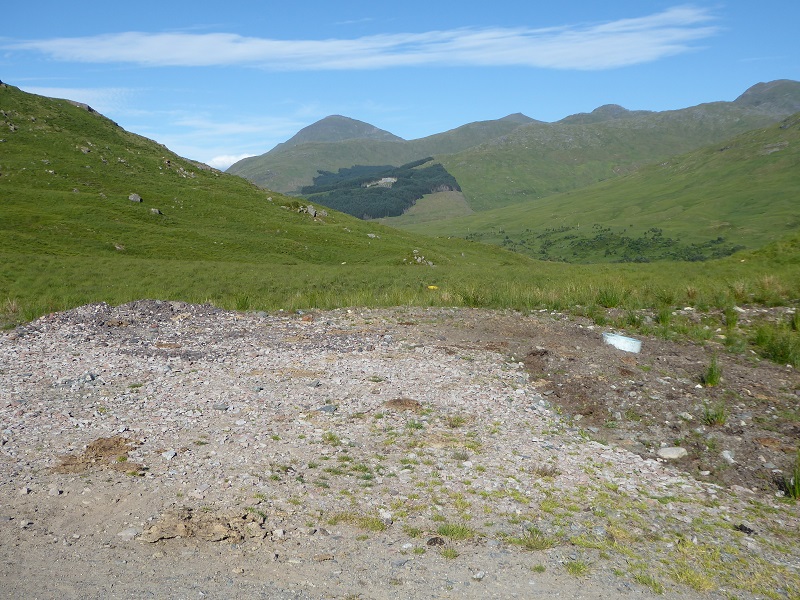
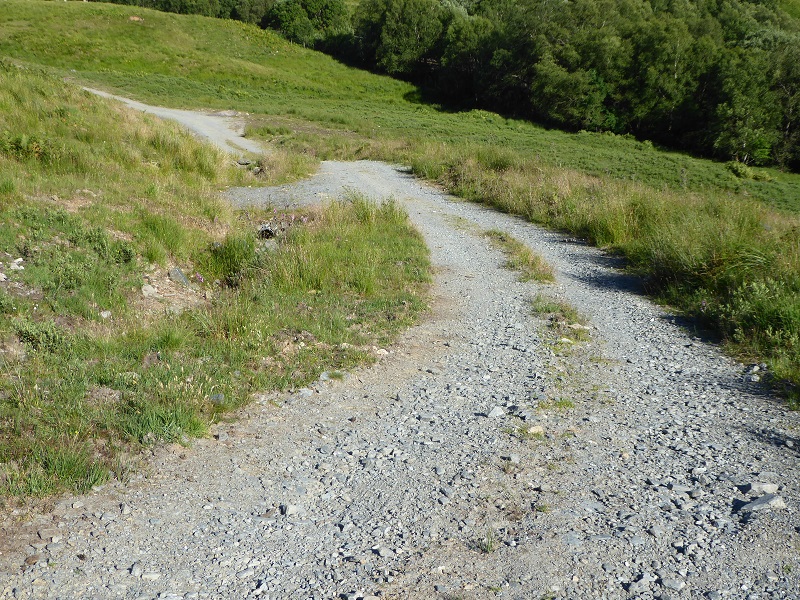
Until the Construction Method Statement is made public its not possible to tell whether the LLTNPA agreed to all these passing places or not. What is clear they increase the landscape impact of the track. They will also have made restoration cheaper. Indeed, one interesting question underlying the landscape impact of hydro schemes across Scotland is the increase in profits to landowners and developers that has resulted from planners allowing them first to cut out the cost of construction track removal and then cutting corners when it comes to restoration. Every time a developer has asked to keep a track the LLTNPA should have been asking them how much money they would save/be taken out of the area as a consequence.
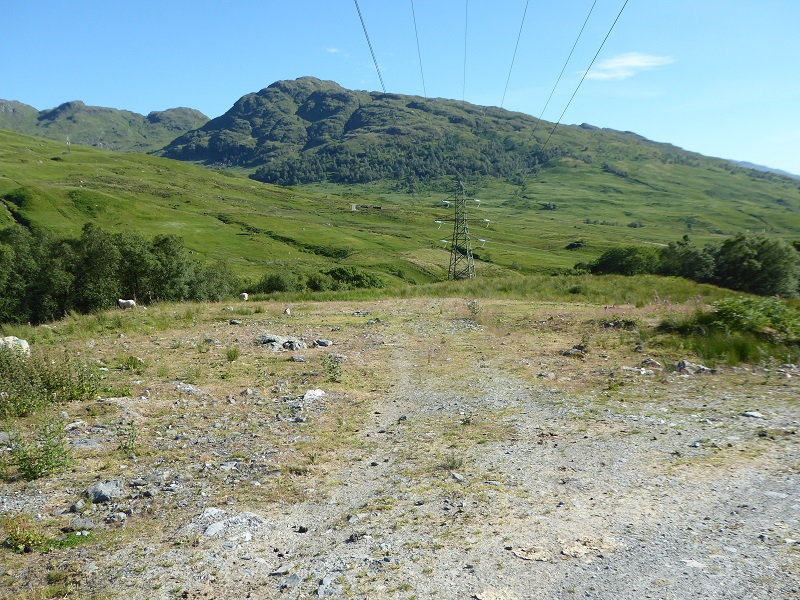
“The overall ecological impacts from a permanent track rather than a temporary track for this scheme are minimal”. Really? Unfortunately the Planning Officer accepted this advice, quoted in their report, from the LLTNPA’s ecology officer.
Unfortunately too, the Planning Officer appears to have accepted, or been told to accept, the Estate’s justification for keeping the track:
It has become increasingly clear that the use of “green” tracks for regular access does not necessarily ensure the minimum impact on the ground. There is inevitably an impact in wetter areas and recovery of the ground can be problematic.
I have asked the LLTNPA what evidence they have that the use of a green track – ie ATVs across the hillside – was problematic as claimed.
The regularly used existing track which would serve intake 2 (Eas Eonan) is showing signs of use and it is clear that more frequent use of the green track would adversely affect this part of the hill.
The evidence strongly suggests that it could hardly be worse than the track the LLTNPA has agreed but in any case that argument is irrelevant: the LLTNPA could, if ground was eroding through use of ATVs, insist schemes were accessed by foot and any materials needed for repair brought in by helicopter. Why would more frequent use be required to maintain the intakes?
Well, more frequent access had nothing to do with the hydro but rather Glen Falloch Estate’s argument that:
The pressures on farming activities, with increased concerns about financial returns, animal welfare and available manpower, not to mention seemingly more frequent extremes of weather, all point towards the major benefit that improved access would bring. The estate itself is increasing its deer cull in order to keep numbers under control in accordance with our commitments to our deer management groups and, again, it is clear to us that improved access would assist this.
Perhaps the LLTNPA could publish figures on many additional deer have been culled as a result of the estate being allowed to retain these tracks and how long they expect it to take before woodland regenerates sufficiently to conceal them?
What needs to happen?
“The main local plan policy for hydro proposals is REN2. This states that proposals for hydro energy generation will be supported where (a) …access requirements and other support infrastructure do not generate a significant adverse impact on landscape, natural or cultural heritage or the water environment individually or cumulatively, including any protected species and habitats under statute;
(f) sufficient landscaping measures are included to integrate the proposal into the landscape setting”…; (Extract from Planning Report).
The evidence from the Eas Eonan and other Falloch Hydro tracks is that none of them has been “integrated” into the landscape setting and that the LLTNPA needs to start evaluating developments far more critically than it has done up till now.
Meantime, the LLTNPA would appear to be just hoping that people will get used to these scars on the landscape. I don’t believe that is acceptable and the LLTNPA should commission an independent review of the impacts of hydro schemes in the National Park. Its time that the LLTNPA devoted more resources to proper research instead of marketing.
As far as solutions go, I would like to see the LLTNPA reviewing all the hydro access tracks it has agreed with a view to replacing them with much narrower footpaths which, if well designed, could be used by small ATVs. The evidence that this could work is available from the Glen Falloch estate itself which drives vehicles along narrow sections of the West Highland Way (see here). The Planning Officer accurately described the issue of broad tracks in her report:
The track is proposed to be reduced to 2.5m with a central strip, appearing as two tyre tracks. Although it would be preferable to reduce this further, it is acknowledged that for this terrain 2.5 metres is a realistic minimum width for a four wheel drive vehicle.
No mention of ATVs which need much narrower tracks than landrovers. Narrower tracks, say 1.5m maximum, would be far less visible in the landscape, as the examples of walker eroded paths in Glen Falloch show, and could be designed to avoid taking lines up steep slopes that erode so quickly. They could also be designed to take a more winding course through the landscape again helping them to blend in. This would allow hydro managers occasional easy access to intakes for light maintenance while at the same time potentially offering a positive recreational experience. The LLTNPA should revise its Renewables guidance to say “high spec footpath capable of carrying a small ATV or nothing” and engaging with managers of existing hydros, as in Glen Falloch, to reinvest their huge profits to make this happen.
An excellent and detailed exposure of how these appalling scars have been permitted by LLTNPA. For me it raises many worrying issues about our planning system and how this is implemented within LLTNPA. I would like to emphasise two issues that seem to be applicable to other planning authority areas, including Cairngorms National Park Authority:
– It seems that applicants initially agree to restore construction access tracks and accept the planning conditions placed on them, then they either just ignore the conditions and if the matter is raised they request that the tracks be retained and put forward weak justifications which the planning authority just accepts. It would appear that this is a ‘learnt’ trick used by many of the estates.
– There is an endemic lack of enforcement of planning obligations by both our National Park Planning Authorities, and I suspect that this problem is now prevalent all over Scotland. Lack of enforcement just encourages the planning applicant to ‘try it on’ and if caught reach a compromise, which is often to take no action by the Planning Authority.
When will the Scottish Government and the Planning Authorities learn these lessons?